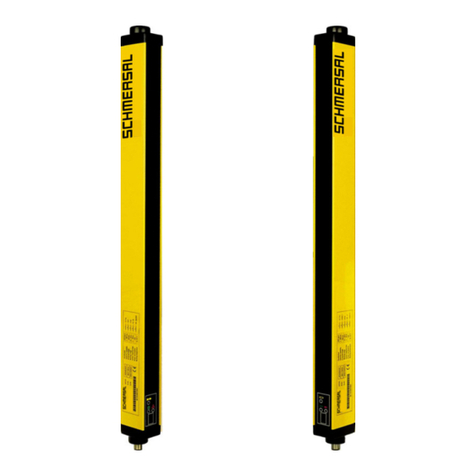3
SLG 420
Operating instructions
Safety light grid
EN
2.5 Technical data
Standards: EN 61496--1, CLC/TS 61496-2,
EN ISO 13849, EN 62061
Material of the enclosure: Aluminium
Number of beams: 2, 3, 4 beams
Protection field heights: 500 mm, 800 mm, 900 mm
Detection ability for test bodies:
2 beams with resolution 500 mm *1
3 beams with resolution 400 mm *1
4 beams with resolution 300 mm *1
Range of the protection field: 0,3 … 18,0 m
8,0 … 40,0 m
Response time: 2 - 4 beams:10 ms (Standard) 2 - 4 beams: 15
ms(beam coding A)
Rated operating voltage: 24 VDC ±10% (PELV) supply unit to
EN 60204 (power drop > 20 ms)
Operating current: 400 mA max. + 0.5 A (OSSD load + output signal
quality load)
Wave length of the sensor: 860 nm
Safety outputs (OSSD1, OSSD2): 2 x PNP-type semi-conductor,
short-circuit proof
Switching voltage HIGH¹: 15 V … 28,8 V
Switching voltage LOW¹: 0 V … 2 V
Switching current: 0 mA … 500 mA
Leakage current²: 1 mA
Load capacity: 2 µF
Load inductance: 2 H
Admissible conduction resistance
between OSSD and load: 2,5 Ω
Supply cable: 1 Ω
Contactor control (EDM)
Input voltage HIGH: 17 V … 29 V
Input voltage LOW: 0 V … 2,5 V
Input current HIGH: 3 mA … 10 mA
Input current LOW: 0 mA … 2 mA
Input restart interlock (manual reset)
Input voltage HIGH: 17 V … 29 V
Input voltage LOW: 0 V … 2,5 V
Input current HIGH: 3 mA … 10 mA
Input current LOW: 0 mA … 3 mA
Function: Protective mode, start and restart interlock
(manual reset), contactor control, beam blanking
Signal times
Contactor control: 50 ms … 500 ms, adjustable
Restart interlock (manual reset): 50 ms … 1,0 s, signal trans-
mission in case of trailing edge
Start interlock: 250 ms … 1500 ms, adjustable
LED indications transmitter: Transmitting, status
LED indications receiver: OSSD ON, OSSD OFF, restart, signal
reception, blanking, multifunction
Connection: M12 connector plug with metal thread, receiver
8-pole, transmitter 4-pole
Ambient temperature: −10° C … +50° C
Storage temperature: −25° C … +70° C
Interface: Diagnostics and function setting
Protection class: IP67 (IEC 60529)
Resistance to vibrations: 10 - 55 Hz to IEC 60068-2-6
Resistance to shock: 10 g; 16 ms; to IEC 60068-2-29
Year of construction: as of 2010 version 1.0
*1 resolution = beam distance + beam diameter 10 mm
²) In case of failure, the leakage current at the most flows to the OSSD
cable. The downstream control element must recognise this state as
LOW. A safety PLC must detect this state.
2.6 Response time (reaction time)
Standard version
The response time of the SLG 420 safety light grid depends on the
number of light beams and the beam coding A.
Resolution 14
Beams
[Number]
Beam
distance
[mm]
Respon-
se time
[ms]
Response time with
beam coding A
[ms]
Weight
[kg]
2 500 10 15 2.5
3 400 10 15 3.5
4 300 10 15 3.6
2.7 Safety classification
Standards: EN ISO 13849-1, EN 62061
PL: up to e
Control category: up to 4
PFH value: 7.42 x 10-9 / h
SIL: up to 3
Service life: 20 years
2.8 Functions
The system consists of a receiver and a transmitter. For the described
functions, no further switching elements are required. For the diag-
nostics and function selection, a user-friendly PC-software is offered as
accessory.
For the connection to a PC, the NSR-0801 BUS converter is required
(not included in delivery).
The system for the version SLC 420 has the following features:
• Protective mode (automatic start after release of the protected field)
• Start interlock
• Restart interlock (manual reset)
• Contactor control EDM
• Beam coding
• Blanking of one beam (only for 3- and 4-beam light grids)
Factory setting
The SLG 420 system features many functions without additional de-
vices. The following table includes an overview of the possible functions
and the configuration of the condition on delivery.
Function Factory setting Configuration
Protective mode not active External wiring
Restart interlock
(manual reset)
not active External wiring
Fixed blanking not active With BUS converter
NSR-0801 and PC-software
Contactor control not active With BUS converter
NSR-0801 and PC-software
Start interlock not active With BUS converter
NSR-0801 and PC-software
Beam coding not active With BUS converter
NSR-0801 and PC-software
2.8.1 Protective mode
The protective mode switches the OSSD outputs to ON state (protec-
tion field not interrupted), without external release of a switching device.
This type of protection generates an automatic restart of the machine if
the protection field is not interrupted.
This operating mode may only be chosen in conjunction with
the restart interlock (manual reset) of the machine.
This operating mode must not be chosen, when persons can
step behind the protection field.





























